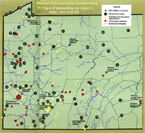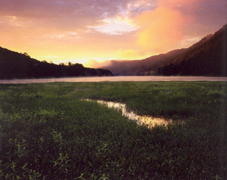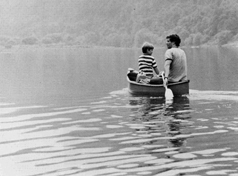|
Conserve |
|
| Conserve 75th Anniversary Commemorative Issue |
| 1930s - 40s |
| 1950s |
| 1960s |
| 1970s |
| 1980s |
| 1990s |
| 2000s |
| Fall 2007 Home |
| Past Issues |
1980s
Protecting the Allegheny River
The 325-mile long Allegheny begins as a trickle from a spring on a hillside in Potter County, Pa. As it gathers its upper tributaries and flows northwest into New York, the Allegheny is essentially just a big creek. But it's the middle section below Warren, Pennsylvania, where the river begins to exhibit its true
character and significance as one of North America's important riverine ecosystems. |
An Interview With John Oliver John Oliver served the longest term of any Conservancy president, spending
more than 17 years guiding this organization. Prior to joining the Conservancy,
Mr. Oliver served In the U.S. Navy where he received a purple heart
during his tour in Vietnam. In 1996, he was asked by then Pennsylvania
Governor Tom Ridge to head the Pennsylvania Department of Conservation
and Natural Resources. |
The Natural Heritage Program
The broadest goals of the modern conservation movement cannot be achieved
without accurate and detailed information. The science of conservation was part of the earliest foundations of Western Pennsylvania Conservancy through the guidance of scientists like M. Graham Netting, Otto Jennings, Frank Preston and others. In 1981, WPC expanded its science role to meet the challenges of a rapidly developing world and partnered to create the Pennsylvania Natural Heritage Program (PNHP). By 2006, WPC took ownership of the program and today conducts research for the entire state.
The work of the Natural Heritage Program is not an end in itself. The resulting biodiversity information is gathered, managed, and most importantly, provided for conservation uses. PNHP includes the Pennsylvania Natural Diversity Inventory database that not only stores information, but is also consulted daily as part of decision-making within government agencies. WPC and other conservation groups use the same information to guide their conservation planning so that protection efforts are efficient and effective. Additionally, the expertise of the PNHP staff is available daily within the organization, making science an integral part of WPC's larger conservation strategy.

1981 WPC established its Natural Heritage Program.
1984 WPC acquired the mineral rights underlying 9,425-acres of unspoiled wilderness around Hickory Creek in Warren County to create the first federally-
designated Wilderness Area in Pennsylvania. The land had more than 90 subsurface owners at the time. The late Senator John Heinz plays an intergral role in protecting this land.
1985 WPC linked Gallitzin State Forest, State Game Lands 26, and Blue Knob State Park with the acquisition of 1,537 wild, remote acres on Allegheny Mountain in the corners of Bedford, Cambria, and Somerset counties.
1986 Western Pennsylvania Conservancy acquires 1,349 acres of road/stream frontage and steep hillsides where Loyalhanna Creek cuts an 800 foot-deep water gap through Chestnut Ridge in Westmoreland County. WPC’s Tom Schmidt
plays an integral part in assembling this acquisition.
A 1,000-acre tract in the Enlow Fork valley, home to rich wildflower displays is protected through the efforts of WPC, a gift from Consolidation Coal (Consol)
of Pittsburgh, and two public agencies for conveyance to the state game commission to create State Game Lands 302 in Greene and Washington counties.
WPC member and Titusville resident Ray Gerard brings the new 31-mile Oil Creek hiking trail to life; on Nov. 21, 1986, a new pedestrian footbridge over Oil Creek, a joint project of WPC and the Pennsylvania Bureau of State Parks, is dedicated.
1987 WPC continues its work on the Clarion River Project with the acquisition of a 674-acre tract in the northern stretch of the river above Hallton, bringing
total property to 6,833 acres.



